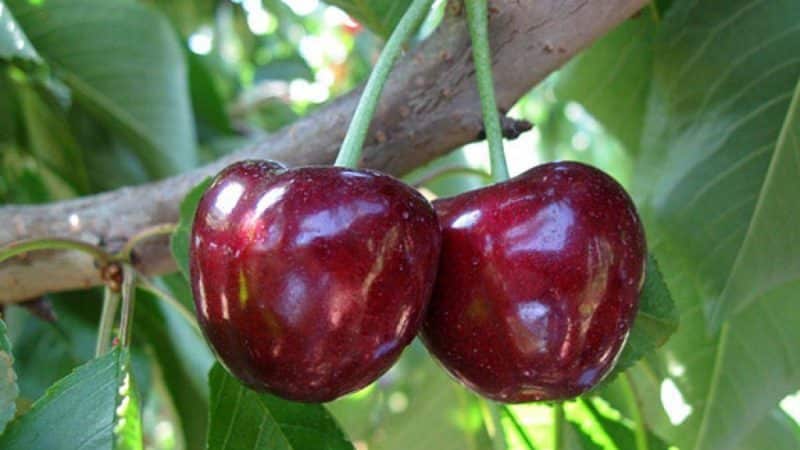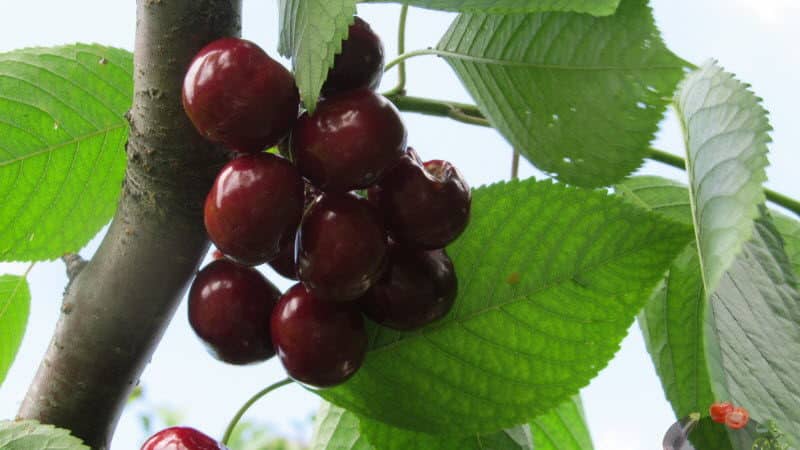What is good about the Bull's Heart cherry variety and why you should try growing it
Cherries grow in many garden plots. The fruits of this tree are loved for their sweetness and juiciness. To get a rich harvest, it is important to choose the highest quality varieties, Therefore, many gardeners give their preference to the Bull's Heart cherry, which is famous not only for its excellent taste, but also for its unpretentiousness.
Description of the cherry variety Bull's Heart
Bull, or Volovye, heart is one of the largest-fruited domestic varieties. It received its name due to the unusual shape of the berries - round, with slight compression, giving them a similarity to the anatomical shape of the heart.
History of origin and distribution

This cherry was bred on the territory of Georgia during the Soviet Union. It was intended for breeding in warm regions: Georgia, Azerbaijan, the republics of Central Asia and the southern zone of Russia. However, the variety has gained such popularity and love from gardeners that many of them have achieved the cultivation of Ox Heart in other regions. This became possible due to the organization of high-quality winter shelter, which allows the cherries to withstand frosts and other bad weather.
Now this variety is also found in regions with harsher climates:
- Middle lane;
- Central Black Earth region;
- North Caucasus;
- Volgo-Vyatsky;
- Nizhne-Volzhsky;
- North-West.
The creators of the variety are considered to be ordinary gardeners, so it is not registered either in Georgia or in Russia.
Characteristics and description of trees
Bull's heart is a medium-sized plant with a pyramid-shaped crown and sparse foliage. The leaves are large in size, dark green in color, pointed at the top and jagged at the edges. The height of a mature tree varies from 3 to 5 m, the final size depends on the quality of the soil. Seedlings develop quickly.
Due to the low growth of the crop, it is convenient to harvest. The density of the crown allows for high-quality ventilation of the tree, avoiding the proliferation of pests and preventing excessive thickening of the foliage.
Cherry blossoms bloom in the second half of May. In temperate climates, the harvest is harvested in July. In the southern zone - at the end of June. They ripen gradually, which allows you to obtain a harvest in several stages. 30-40 kg are collected from one tree.
Temperature resistance
In the southern regions, berry trees easily tolerate low temperatures. In the middle zone, where frosts down to -25°C are possible in winter, freezing of branches and shoots occurs. In temperate climates, it is important to carry out proper and timely preparation for wintering and provide the plant with good protection from the cold.
In spring, you should be wary of return frosts, which can cause the death of flowers.
Moisture and drought resistance
The bull's heart equally dislikes drought and excess moisture. Excessive, prolonged precipitation can lead to spoilage of berries. During drought, the tree is watered regularly, otherwise the cherry fruits will not reach their maximum size. The juiciness of the crop depends on watering.
Resistance to diseases and pests
To most diseases characteristic of the cherry crop, Ox's Heart has natural immunity. Of the pests, only a few are dangerous - cherry fly and cherry moth.
Read also:
Sustainable and productive cherries Valery Chkalov.
A weather-resistant variety of Vasilisa cherries with large and tasty berries.
A young, but gaining popularity among gardeners, cherry variety Revna.
Characteristics and description of berries

The average weight of one Ox's heart berry is 7-8 g. It is characterized by a dense skin of a bright red, wine color. The pulp is slightly lighter than the shell and has a pronounced sweet taste with a slight sourness. On a 5-point scale, the fruits of this variety have the maximum rating. The stalk is easily separated without damaging the berry.
Attention! Despite the fact that the skin of the Ox Heart is dense, it bursts easily, which reduces the transportability of the berries.
The harvest is carefully harvested - crushed and damaged berries cannot be stored.
Areas of use
Experts call Ox's Heart a universal dessert variety. The berries are consumed fresh, dried, frozen and canned.
The fruits are used:
- in juices and nectars;
- in homemade wines and liqueurs;
- in the production of confitures and jams;
- in confectionery products;
- in milkshakes.
The fruits contain a huge amount of vitamins and beneficial microelements. Their calorie content is low - only 52 kcal per 100 g.
Advantages and disadvantages of the variety
Before planting this plant on your site, you need to understand the pros and cons of the variety.
The advantages include:
- High yield.
- Stable annual fruiting.
- Appearance and taste of berries.
- Natural immunity to certain pests and types of fungal diseases.
- With proper care, trees are frost-resistant.
- Relative resistance to drought.
The only downsides are the short shelf life of ripe berries and difficulties during transportation.
Growing technology
It is best to buy seedlings in specialized stores and nurseries. Plant for landings should have an even trunk of a single color, without damage to the bark. The presence of buds and green foliage is a must.
The roots of the seedling must be moistened, well developed and free of damage, knots and compactions.
Optimal conditions
Ox heart cannot be planted in regions where the thermometer drops below -25°C in winter. Areas located in lowlands are not suitable, since stagnant water significantly affects the yield of trees. They will grow and bear fruit best in fertile and loose soil with moderate acidity.
The soil is prepared 1-2 months before planting. The selected area is dug up, loosened and cleared of weeds and roots. The soil is mixed with humus and fertilizers. If the soil is highly acidic, it is limed.
The hole for the seedling must be prepared 2-3 weeks before planting. The top soil (about 20 cm) is the most fertile, so it is mixed with humus and laid on the bottom on top of the drainage. The soil is watered and a support peg is driven in.
Landing dates and rules
Planting is carried out in early spring, after frosts have ended. This time is enough for the seedling to take root and properly prepare for wintering.
Some gardeners plant Ox's Heart in the fall, but then the tree may not survive the winter and die.
The variety is light-loving, so the best place for it is a sunny area on the south side, protected from drafts and the north wind.Groundwater should be no higher than 3 m, otherwise the roots will rot.
The distance between plants is about 1.5-2 m, and between rows - 3-5 m. It is important to choose the right location, which will increase productivity and protect trees from pests and diseases. Ideal neighbors would be other varieties of crops and cherries.
Important! Cherries will not make friends with apple trees, pears, gooseberries, raspberries, tomatoes and peppers.
Further care
The seedling is watered regularly - about 2 times a month, at least 3 liters at a time. Young trees are fertilized with manure or ammonium nitrate solution. After each watering, the soil is loosened to make it easier for the plant to obtain oxygen. The last time the tree is watered is in the fall, before the leaves fall.
The crown is formed during the first 3 years. Every spring, cherries are cleaned - dried, damaged branches are cut off. The root growth is removed, and if the crown is too dense, it is thinned out to ensure air flow.
Possible problems, diseases, pests
In late spring or early summer, you may notice small brown spots on tree leaves.. After some time, the affected foliage dries out and falls off. In rare cases, spots occur on fruits. This is how the fungal disease coccomycosis manifests itself.
The affected parts of the plant are removed and burned. During bud ripening, trees are treated with fungicides, and after harvesting they are sprayed with Bordeaux mixture.
Gray rot (moniliosis), which manifests itself in the form of burn spots and gray plaque on the fruits and leaves of the tree, is also dangerous. For the purpose of prevention and treatment of diseased plants, preparations with a high copper content are used.
During the flowering period, cherries can become infected with verticillium.The fungus creates wounds on the bark and causes flowers to wilt, putting the harvest at risk. A solution of copper sulfate can solve this problem.
The most dangerous pests are:
- Cherry fly. The insect lays eggs in green berries. Immediately after hatching, the larvae begin to devour the flesh from the inside.
- Cherry moth. Affects buds, leaves and young shoots of cherries.
Solving pest problems comes down to the use of special insecticides. They should not be used several weeks before harvest.
Wintering
With the onset of autumn, trees prepare for winter rest:
- Water abundantly - up to 100 liters of water throughout the autumn season for each tree.
- The soil around the tree is cleared of branches and withered grass, loosened and covered with humus.
- The lower part of the trunk is wrapped in mesh or burlap.
- If severe frosts are expected, the roots are covered with spruce branches.
- The seedlings are hidden for the winter under special materials.
Reproduction
Cherries are propagated by cuttings. The cuttings are taken from the lower branches of the mother tree at the end of summer, after harvesting. This method helps to obtain seedlings that can bear fruit before 4 years. The grown tree will be similar to the mother tree; The main thing is to provide proper care.
Features of cultivation depending on the region
In the southern zone of Russia, the Bull's Heart cherry does not require special conditions other than sufficient watering during periods of drought.
In colder regions, special attention is paid to organizing wintering and insulating trees during flowering, if there is a threat of severe frosts.
Pollinator varieties
Ox heart is a partially self-fertile variety. Some varieties of this crop and cherry trees are suitable as pollinators.The main condition is the coincidence of flowering dates.
The most suitable varieties of cherries:
- And the way;
- Ovstuzhenka;
- Tyutchevka.
Cherry:
- Putinka;
- English early.
Reviews from gardeners
Summer residents speak positively about the Bull's Heart cherry.
Irina Fedorovna, Rostov: “I have been growing this variety for 6 years. Easy to care for, produces a good harvest, the berries are very tasty and sweet. But they cannot be stored for a long time. On the third day they start to deteriorate.”
Valentina Ivanovna, Kursk: “We breed the bull’s heart for sale. They sell out quickly, the berries are very tasty, so there is practically no waste. The variety is unpretentious in care, the trees have never been sick in all this time.”
Tatyana Ivanovna, Krasnodar: “We planted the crop 8 years ago, and 5 years later we harvested the first harvest. The berries are large and very tasty; everything is eaten within a few days.”
Conclusion
As can be seen from the reviews, it is not for nothing that Ox’s Heart is popular among gardeners. Everyone notes the exceptional taste of the fruits and their size, while the culture is not capricious, it is easy to care for. And frost resistance makes the variety even more attractive.